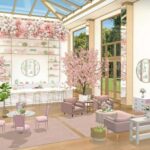Are you looking to transform your living space into a cozy and stylish oasis? In this article, you will learn how to decorate your home and create a space that truly reflects your personality and taste. Home decoration plays a crucial role in enhancing the ambiance of your living environment, making it a place where you can feel comfortable, relaxed, and inspired.
Your home is an extension of yourself, so it’s important to understand why home decoration matters. By taking the time to decorate your space thoughtfully, you can create a sanctuary that speaks to who you are and what brings you joy. Whether you prefer a minimalist aesthetic or love bold patterns and colors, the way you decorate your home can have a significant impact on your mood and overall well-being.
Throughout this article, we will guide you through various aspects of home decoration, from understanding your personal style to selecting the right color palette for your space. We will explore the power of furniture arrangements, the importance of lighting in creating ambiance, and how accessories can add personality to any room. Join us as we delve into DIY projects, seasonal decor ideas, expert tips from interior design professionals, all aimed at helping you turn your house into a beloved home.
Understanding Your Personal Style
When it comes to decorating your home, one of the most important aspects is understanding your personal style. Your home should be a reflection of who you are and what you love. To do this effectively, start by taking a look at your wardrobe. The clothes you wear often reflect your personal style and can give you clues on the colors, textures, and patterns that resonate with you.
To further discover what you love, create a mood board or Pinterest board filled with images that inspire you. Look for common themes in these images such as clean lines, bold colors, or cozy textures. This exercise can help you pinpoint your design preferences and guide you in making decisions when decorating your home.
Once you have a better understanding of your personal style, start translating that into your home decor choices. Consider creating a list of must-have elements that align with your style preferences. This can include specific colors, furniture styles, or decorative accessories that speak to you. By staying true to what you love, you can create a space that truly feels like home.
- Take inspiration from fashion and create a mood board
- Identify common themes in the images on your mood board
- Create a list of must-have elements for your home decor
Color Theory 101
When it comes to decorating your home, selecting the right color palette can truly make a difference in the overall look and feel of your space. Colors have the power to evoke certain emotions, create a sense of harmony, and set the tone for each room in your home.
By understanding basic color theory principles, you can create a cohesive and visually appealing environment that reflects your personal style. Here are some tips to help you choose the perfect color palette for your home:
- Start by considering the mood you want to create in each room. Warm colors like reds, oranges, and yellows can add energy and vibrancy, while cool colors like blues, greens, and purples are calming and soothing.
- Think about the natural light in each room and how different colors will be affected by it. Lighter colors can make a small room feel more spacious, while darker colors can create a cozy atmosphere.
- Don’t be afraid to experiment with different combinations of colors. You can use tools like color wheel to help you find complementary or analogous colors that work well together.
By taking the time to learn about color theory and applying these principles to your home decor, you can create a space that not only looks beautiful but also feels harmonious and balanced. Remember that choosing the right color palette is a personal decision, so trust your instincts and go with what feels right for you.
- Consider creating an accent wall in a bold color to add visual interest to a room without overwhelming the space.
- Use neutrals like whites, grays, and browns as a base for your color palette, then add pops of color through accessories like pillows, rugs, and artwork.
- Don’t forget about the impact of texture on color – combining different textures like velvet, linen, or wood can enhance the richness of your chosen hues.
Whether you prefer soothing pastels or dramatic jewel tones, learning how to play with color in your home decor will allow you to express your unique personality and create a space that truly feels like home. Experiment with different shades, tones, and combinations until you find the perfect color palette that speaks to you.
Furniture Basics
When it comes to decorating your home, selecting the right furniture is crucial in creating a space that is not only functional but also reflects your personal style. The furniture you choose can truly make or break the overall look of a room, so it’s important to take the time to carefully consider your options.
Whether you prefer modern minimalist pieces or cozy and traditional furnishings, there are some key factors to keep in mind when selecting furniture for your home.
Consider Your Space
Before you start shopping for furniture, it’s essential to assess the size and layout of the room you are decorating. Take measurements of the space and consider how much room you have for different pieces of furniture. Make sure to leave enough space for easy movement around the room and ensure that the furniture you choose will fit comfortably without overwhelming the space.
Think About Functionality
When selecting furniture for your home, it’s important to think about how each piece will be used. Consider your lifestyle and needs – do you need a large sectional sofa for family movie nights or a sleek dining table for hosting dinner parties? Choose furniture that not only looks great but also serves a practical purpose in your daily life.
Stay True to Your Style
While it can be tempting to follow trends or choose pieces based on what is popular at the moment, it’s crucial to stay true to your personal style when selecting furniture for your home. Whether you love mid-century modern designs or rustic farmhouse charm, choose pieces that resonate with you and create a cohesive look throughout your living space.
Remember, your home should be a reflection of who you are, so don’t be afraid to let your style shine through in every piece of furniture you select.
The Power of Accessories
Accessories play a vital role in transforming a house into a home that reflects your personality and style. These decorative pieces can add character, charm, and warmth to any space, making it feel more inviting and personalized. From statement pieces to small accents, accessories can elevate the overall look of your home and tie together the various design elements.
Choosing the Right Accessories
When selecting accessories for your home, it is essential to consider your personal style and the existing decor. Opt for pieces that speak to you and bring joy when you look at them. Whether it’s vibrant throw pillows, unique art pieces, or eclectic sculptures, choose items that resonate with you on a deeper level. Additionally, pay attention to the color scheme and theme of your space to ensure that the accessories complement rather than clash with the overall design.
Creating Visual Interest
Accessorizing your home is not just about adding decorative elements; it’s also about creating visual interest and balance in your space. Mix and match different textures, shapes, and sizes to create a dynamic look that captures attention. Consider incorporating metallic accents for a touch of glamour or adding natural elements like plants or wooden decor for warmth and texture. By layering different accessories strategically throughout your home, you can create a cohesive and visually appealing atmosphere.
Personalizing Your Space
Accessories offer an excellent opportunity to showcase your personality and interests in your home decor. Whether you display travel souvenirs, family heirlooms, or handmade crafts, these personal touches can make your space feel uniquely yours. Consider creating vignettes or curated displays that tell a story about who you are and what you love. Remember, decorating with accessories is an ongoing process – feel free to switch things up periodically to keep your space fresh and exciting.
Lighting Matters
Lighting plays a crucial role in home decoration as it can completely transform the ambiance and functionality of a space. Proper lighting can make a room feel cozy, open, spacious, or intimate depending on the type of lighting fixtures used. When learning how to decorate your home, understanding the different types of lighting and how they interact with your space is essential.
One important aspect of lighting in home decor is the distinction between ambient, task, and accent lighting. Ambient lighting provides overall illumination for a room, while task lighting focuses on specific areas where activities such as reading or cooking take place. Accent lighting is used to highlight specific features like artwork or architectural elements. By incorporating a mix of these three types of lighting, you can create a well-balanced and inviting atmosphere in your home.
When selecting lighting fixtures for your space, consider both form and function. Choose fixtures that not only complement your personal style but also provide adequate light for the activities carried out in each room. Additionally, pay attention to the color temperature of the light bulbs you use as it can affect the mood of the space.
Warm tones are cozy and inviting, while cooler tones are energizing and bright. Experimenting with different combinations of lighting fixtures and bulbs can help you achieve the perfect ambiance in your home.
| Aspect | Importance |
|---|---|
| Ambient Lighting | Provides overall illumination |
| Task Lighting | Focuses on specific areas for activities |
| Accent Lighting | Highlights specific features like artwork |
DIY Home Decor Projects
Decorating your home doesn’t have to break the bank. In fact, DIY home decor projects can be an affordable and fun way to add a personal touch to your space.
Whether you’re looking to revamp a room or simply add some new elements to freshen up your home, there are plenty of creative ideas that you can tackle on a budget. From upcycling old furniture to creating your own artwork, the possibilities for DIY home decor projects are endless.
One popular DIY project is repurposing old items into new, functional pieces for your home. For example, you can turn an old wooden ladder into a stylish bookshelf, or transform mason jars into unique light fixtures.
Not only are you saving money by using what you already have, but you’re also adding a one-of-a-kind element to your home that can’t be found in stores. DIY projects allow you to showcase your creativity and make your space truly unique.
Another budget-friendly DIY home decor idea is creating your own artwork. You don’t have to be an art expert to craft beautiful pieces for your walls. Get creative with canvas paintings, framed prints, or even macramé wall hangings. Not only will these pieces add personality and style to your home, but they will also serve as conversation starters when guests come over. Embrace the opportunity to infuse your space with handmade art that reflects your taste and creativity.
| DIY Project Ideas | Benefits |
|---|---|
| Repurposing old items | Cost-effective and environmentally friendly |
| Creating artwork | Adds personal touch and sparks conversations |
Whether you’re sprucing up a room for yourself or preparing for guests, DIY home decor projects offer a rewarding experience that allows you to express yourself through design. By taking on these projects, not only will you save money, but you’ll also create a space that truly feels like home – filled with memories and creativity that reflect who you are as an individual. So roll up your sleeves and get ready to unleash your inner decorator.
Seasonal Decor
As the seasons change, it’s the perfect opportunity to update and refresh your home decor. Seasonal decor not only adds a touch of festivity to your space but also allows you to incorporate different textures, colors, and elements that reflect the time of year. Whether it’s swapping out throw pillows, changing up artwork, or adding seasonal accents like pumpkins in the fall or shells in the summer, seasonal decor can instantly transform your home.
When refreshing your home decor throughout the year, consider incorporating elements from nature that are specific to each season. For example, during the spring and summer months, bring in fresh flowers or potted plants to add a vibrant touch to your space.
In the fall and winter, consider using cozy textiles like wool blankets or faux fur throws to create a warm and inviting atmosphere. By embracing seasonal elements in your decor, you can create a harmonious environment that aligns with the changing weather outside.
One budget-friendly way to update your home decor for each season is to repurpose items you already have or invest in versatile pieces that can be easily transitioned from one season to another. For example, investing in neutral furniture pieces allows you to switch out accessories like decorative pillows and throws without having to completely overhaul your space.
By following these tips and being mindful of seasonal changes, you can learn how to decorate your home throughout the year while staying true to your personal style and preferences.
Expert Tips and Tricks
Interior design professionals can offer valuable insights and tips to help you elevate the look of your home. By learning from their expertise, you can create a space that not only looks beautiful but also functions well for your lifestyle. One important tip from interior designers is to always start with a plan.
Before buying any new furniture or accessories, take the time to create a cohesive design concept for your space. This will help ensure that everything comes together harmoniously in the end.
Another tip from interior design professionals is to play with texture and layering in your home decor. Mixing different textures like velvet, linen, and wood can add depth and visual interest to a room. Likewise, layering different elements such as rugs, throw pillows, and curtains can create a cozy and inviting atmosphere. Experimenting with texture and layering can help transform a bland space into a warm and inviting home.
Lastly, interior design professionals often recommend investing in quality pieces that will stand the test of time. While it may be tempting to opt for trendy furniture or accessories, it’s important to consider longevity when decorating your home.
Quality pieces may come with a higher price tag initially, but they will likely remain in style for years to come. By following these expert tips and tricks, you can learn how to decorate your home like a pro and create a space that reflects your personal style and taste.
Conclusion
In conclusion, learning how to decorate your home is not just about making it visually appealing, but also about creating a space that truly reflects who you are. By understanding the importance of home decoration and the impact it can have on your well-being, you can transform your living space into a sanctuary that brings you joy and comfort every day.
As you go through the process of discovering your personal style, choosing the right color palette, selecting furniture pieces, adding accessories, illuminating your space with the right lighting, and even getting creative with DIY projects on a budget, remember that each decision you make contributes to the overall ambiance of your home. Embrace each step as an opportunity to express yourself and create a living environment that resonates with your personality and preferences.
Don’t forget to seek inspiration from interior design professionals for expert tips and tricks that can elevate your home decor game. With a little guidance and creativity, you can turn your home into a reflection of your unique taste and style. Remember, decorating your home is an ongoing process that allows you to evolve with your space over time. So go ahead and start transforming your living space into a place that feels truly like home.
Frequently Asked Questions
How to Decorate Your Home for Beginners?
Decorating your home as a beginner can feel overwhelming, but remember to start small. Focus on one room at a time and choose a color scheme or theme to guide your decor choices. Utilize online resources for inspiration and don’t be afraid to experiment with different styles until you find what works for you.
What Are the 7 Principles of Interior Design?
The seven principles of interior design are unity, balance, rhythm, emphasis, proportion, scale, and harmony. Unity refers to the cohesive flow throughout a space, while balance ensures visual stability.
Rhythm creates movement and visual interest, emphasizing focal points in the room. Proportion and scale help maintain proper sizing of elements within the space, while harmony brings it all together with a sense of cohesion.
How Do I Get Started in Interior Decorating?
To get started in interior decorating, consider taking courses or workshops to develop your skills and knowledge base. Gain experience by helping friends or family with their spaces, or even offering your services at a reduced rate to build up a portfolio.
Networking with professionals in the industry can also provide valuable insights and opportunities for growth in your interior decorating journey.

I’m thrilled to be your companion on this exciting journey through the world of home decor and design. With a passion for turning houses into homes and a keen eye for the finer details, I’m here to help you transform your living spaces into beautiful, functional, and meaningful havens.





